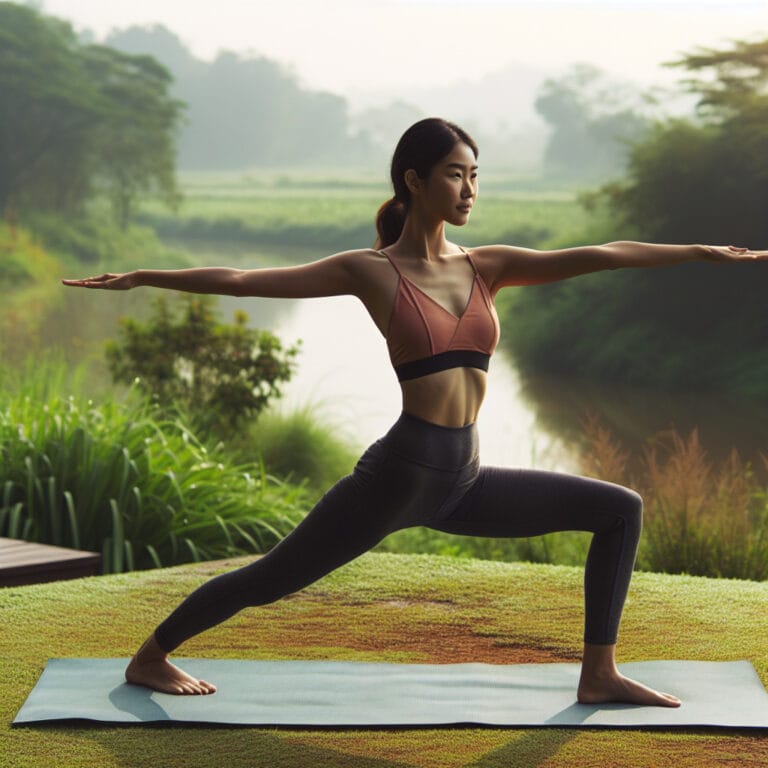
10 Yoga Poses to Enhance Concentration and Boost Memory Power
Table of Contents
- Introduction
- Lotus Position (Padmasana)
- Mountain Pose (Tadasana)
- Standing Forward Bend (Uttanasana)
- Tree Pose (Vrikshasana)
- Warrior II (Virabhadrasana II)
- Child’s Pose (Balasana)
- Seated Forward Bend (Paschimottanasana)
- Camel Pose (Ustrasana)
- Corpse Pose (Savasana)
- Headstand (Sirsasana)
- Conclusion
- Frequently Asked Questions
Introduction
The ancient art of yoga goes beyond mere physical exercise; it is a holistic approach to well-being that encompasses the mind, body, and spirit. Regular practice of yoga exercises can have a transformative effect on cognitive functions, such as improving memory and concentration. Science has begun to shed light on this connection, revealing how meditation contributes to improved concentration by engaging the brain in mindful breathing exercises. Intentional breathing calms the nervous system, reducing stress and promoting mental clarity—a state wherein our cognitive abilities are at their peak.
By incorporating specific yoga asanas into one’s routine, students and professionals alike can unlock the psychological benefits that enhance mental acuity. For instance, effective poses such as the Twelve Poses of Surya Namaskar improve not only physical health but also stimulate blood flow to the brain. Improved blood flow ensures an adequate supply of nutrients, positively impacting cognitive function. Additionally, yogic techniques involving focused concentration like pranayama technique balances both sides of the brain—this potent method promotes mental clarity and improves memory recall.
Among these powerful yoga postures is Vrikshasana (Tree Pose), which enhances concentration by demanding focus and balance; while Padmasana (Lotus Position) stretches the spine promoting blood circulation throughout the body including the brain area. A relaxing pose like Balasana (Child’s Pose) relieves stress from both body and mind—a necessary reset for a focused mind at work or study. Furthermore, inversions such as Sirsasana (Headstand) encourage an influx of oxygen-rich blood to cerebral tissue; whereas Sarvangasana (Shoulder Stand) enhances overall blood circulation.
In essence, each posture plays an essential role in sharpening one’s mental faculties through various mechanisms: some engage your core stability enhancing alertness while others soothe your nervous system paving way for deeper introspection or learning retention. The beauty lies in their synergy—when practiced sequentially or selectively based on individual needs.
To integrate this wisdom into daily life means more than adopting a fitness regimen—it’s embracing a comprehensive lifestyle change where regular practice positively influences cognitive functions over time. As we dive deeper into understanding these timeless techniques further down our exploration in this article series, it becomes evident how every intentional stretch or breath taken holds potential for profound inner transformation leading towards not just better physical health but also superior intellectual prowess.
Lotus Position (Padmasana)
Embracing the practice of yoga exercises for mental acuity invites a profound transformation beyond physical benefits; it is a gateway to enriched cognitive capabilities. The time-honored Lotus Position, or Padmasana, is particularly revered in the yoga tradition for its ability to enhance concentration and memory. As practitioners sit in this quintessential asana, they engage in mindful breathing that calms the nervous system and reduces stress, laying the foundation for promoting mental clarity. This intentional focus on breath aligns with meditation’s contribution to improved concentration—a peaceful mind becomes fertile ground for memory retention and sharp focus.
Proper execution of Padmasana requires awareness of one’s body alignment—the spine must be erect while deep, rhythmic breathing enriches each cell with oxygenated blood. This deliberate positioning not only improves posture but encourages an unobstructed flow of nutrients essential for cognitive function. Regular practice positively influences the brain’s blood flow, ensuring an adequate supply of these vital resources that underpin sharper intellect.
Moreover, yogic technique involving focused concentration such as Pranayama balances both hemispheres of the brain and enhances overall cerebral circulation. Incorporating specific yoga asanas like this into daily routines proves invaluable for students and professionals alike—each pose holds the key to unlocking psychological benefits through their essential role in stimulating both physical health and mental resilience.
In essence, yoga postures serve not merely as exercises but embody potent methods that promote mental clarity alongside improving balance and flexibility. The Twelve Poses of Surya Namaskar improve upon those benefits by invigorating every part of your being with dynamic movement that keeps both mind and body agile. By integrating these effective poses into your lifestyle, you commit to a path where regular practice stands at the core—fueling cognitive functions with each intentional stretch and breath taken towards achieving tranquility and acute mental prowess.
Mountain Pose (Tadasana)
Amidst the tranquility of a serene yoga studio, the Mountain Pose (Tadasana) stands out as a foundation for postural alignment and mental acuity. This seemingly simple stance is a cornerstone in the world of yoga exercises, offering practitioners an opportunity to ground themselves in the present moment while reaping benefits for both mind and body. As one engages in Tadasana, mindful breathing becomes intertwined with physical steadiness, creating an environment where improved concentration and cognitive clarity flourish.
Mastering this essential pose begins with standing firm, feet rooted to the earth as if embodying the strength of a mountain. With each intentional inhale and exhale, tension dissipates from the body, allowing for optimal spinal alignment—an intrinsic component not only for posture enhancement but also as a conduit for unimpeded blood flow to nourish brain tissues. The act of focusing on breath control is itself meditative; it calms the nervous system reducing stress which is crucial in promoting mental clarity that sharpens memory recall.
Yoga asanas like Tadasana do more than improve balance—they serve as potent tools that enhance concentration by fostering a focused mind amidst life’s chaos. Regular practice embeds these benefits into our daily lives; students find their attention heightened during studies, while professionals navigate tasks with greater efficiency. By incorporating specific poses such as Tadasana into your routine alongside dynamic sequences like Twelve Poses Surya Namaskar or invigorating Pranayama technique balances¸ you consciously pave your way towards psychological resilience—a testament to how yoga postures promote physical health while playing an essential role in cognitive empowerment.
Standing Forward Bend (Uttanasana)
Amid the myriad of yoga exercises designed to foster a serene mental state, Uttanasana, or Standing Forward Bend, emerges as a beacon for stress reduction and cognitive rejuvenation. This potent asana stretches the spine and hamstrings, inviting a rush of blood to the brain—a natural antidote to the fog of fatigue. As practitioners hinge at their hips and elongate their torso towards the earth, they engage in mindful breathing that serves as an anchor for wandering thoughts. The intentional breathing calms both body and mind, facilitating a release of tension that so often impedes concentration.
To perform Uttanasana with utmost efficacy requires attention to form; one must stand with feet hip-width apart, exhale deeply while folding forward from the pelvis—maintaining length in the spine—and place hands beside feet or on shins for support. It’s a pose that not only improves posture but enhances circulation throughout every system within our bodies including those governing our nerves.
The psychological benefits garnered from this relaxing pose are manifold: as stress dissipates under its soothing influence, mental clarity blossoms. Those who regularly incorporate Uttanasana into their practice report heightened awareness and improved memory recall—testament to how yoga postures promote physical health while playing an essential role in elevating cognitive functions. Such is the power of yoga—asanas like Uttanasana guide us into deeper introspection, where we find tranquility amidst life’s tumultuous demands and emerge with focused minds ready to embrace challenges anew.
Tree Pose (Vrikshasana)
Yoga asanas like Vrikshasana, or Tree Pose, are not just physical exercises; they’re a dance of balance and stability that mirrors the steadiness required for optimal mental function. As you position your foot on the inner thigh of the opposite leg, pressing hands together in prayer position at heart center, your body demands focus—a singular point of concentration that embodies meditation contributes to improved concentration. This intentional alignment fosters a focused mind essential for maintaining Vrikshasana’s delicate equilibrium. The mindful breathing synchronized with such balance-oriented poses calms the nervous system reducing stress, which is pivotal in promoting mental clarity and enhancing cognitive functions.
The quiet strength cultivated in Tree Pose reflects the potency inherent in regular practice positively influencing cognitive abilities—each instance where one wobbly stands yet persists hones our ability to improve memory and improve concentration off the mat. Like roots drawing nutrients from soil, effective poses like this channel blood flow to the brain; improved blood flow ensures an adequate supply of oxygen and nutrients positively impacting cognitive function. By incorporating specific yoga asanas into daily life—practicing Twelve Poses Surya Namaskar or Pranayama technique balances—the psychological benefits extend beyond flexibility and endurance: they reshape our very approach to learning and remembering.
Thus, yoga postures promote not only physical health but play an essential role in sharpening intellect—an invaluable tool for students seeking academic excellence or professionals striving for peak performance. With every poised stance amidst fluctuating circumstances, yoga teaches us that true power lies within a calm center—a lesson as profound on the canvas of consciousness as it is within each serene movement upon our mats.
Warrior II (Virabhadrasana II)
Harnessing the ancient wisdom of yoga asanas, Virabhadrasana II (Warrior II Pose) stands not only as a testament to historical valor but also as a modern ally in the quest for mental acuity. This dynamic stance, rooted in the lore of the fearsome warrior Virabhadra, embodies strength and concentration. As practitioners adopt this powerful pose, they engage in mindful breathing that synergizes with muscular energy to create a focused mind and a fortified body. The precise alignment—front knee bent over the ankle, back leg active and straight, arms extended with gaze over the front hand—demands attention to detail that stimulates neural pathways involved in improved concentration.
Regular practice positively influences cognitive functions by promoting blood flow to the brain; an adequate supply of nutrients is ensured through this increased circulation. Additionally, Warrior II enhances balance and stability—a metaphor for mental resilience amidst life’s challenges. This effective pose improves posture while its expansive nature encourages an openness conducive to stress relief and psychological benefits.
The essence of adopting Warrior II goes beyond physical conditioning; it invites practitioners into deeper introspection on their journey towards enhancing concentration. Incorporating specific yoga asanas such as this potent method promotes not just physical health but mental clarity too—a dual advantage for memory students or anyone seeking peak intellectual performance. Engage with Virabhadrasana II regularly alongside other yoga exercises like Pranayama technique balances or Twelve Poses Surya Namaskar improvements to unlock your potential for supreme focus and cognitive empowerment.
Child’s Pose (Balasana)
Diving into the restorative depths of yoga, Child’s Pose (Balasana) emerges as a sanctuary for the overstimulated mind, offering a retreat where mental and physical tensions dissipate. This nurturing asana stretches not just the spine but also envelops practitioners in a cocoon of tranquility, encouraging mindful breathing that unlocks a state of profound calmness. As individuals assume Balasana—kneeling down, folding forward with arms extended or by their sides—the nervous system is gently coaxed into relaxation, making space for promoting mental clarity and improved concentration.
Proper execution of this relaxing pose involves settling your sit bones towards your heels as you exhale deeply; forehead resting on the ground to symbolize surrendering worldly concerns. Intentional breathing calms the mind while enhancing blood circulation to brain regions pivotal for memory retention and cognitive function. Regular practice positively influences these cognitive functions, turning Balasana into an effective tool for refocusing during moments when distractions loom large.
Incorporating specific yoga asanas like Child’s Pose into daily life unfolds numerous psychological benefits—each breath serving to nourish brain cells with increased oxygen uptake. The pose improves posture invitingly while its passive nature stands in contrast to active poses that enhance balance and strength. By engaging in this potent method consistently alongside sequences such as Twelve Poses Surya Namaskar improvements or Pranayama technique balances¸ one fosters a focused mind ready to approach tasks with renewed vigor—a testament to how essential yoga postures play an integral role in not only maintaining physical health but also elevating our intellectual capacities.
Seated Forward Bend (Paschimottanasana)
Harnessing the restorative power of yoga, Seated Forward Bend (Paschimottanasana) stands as a pinnacle in nourishing the spine and awakening the nervous system, two cornerstones for cognitive vitality. When performed with precision, this introspective asana stretches the entire backside of the body, from heels to head, and invites a surge of blood flow to the brain—propelling an improved supply of nutrients and oxygen that are crucial for mental acuity. As practitioners embark upon Paschimottanasana, they should commence seated with legs extended forward; a deep inhalation prepares them to elongate their spine upward before exhaling guides them into a gentle fold over their legs. The integration of mindful breathing is paramount; it not only deepens the pose but also ensures intentional breathing calms the nervous system reducing stress while promoting mental clarity.
Diligent practice of this potent method promotes mental clarity and improves memory by enhancing cerebral circulation—a boon for memory students immersed in academic endeavors or professionals seeking sharpened focus. Moreover, as yogic technique involving focused concentration manifests through each stretch, Paschimottanasana fortifies one’s ability to enhance concentration. Whether incorporated within Twelve Poses Surya Namaskar improvements or paired with Pranayama technique balances¸ this effective pose catalyzes psychological benefits that transcend physical realms: yoga postures promote physical health while playing an essential role in sculpting resilient minds equipped to navigate life’s complexities.
Camel Pose (Ustrasana)
Ustrasana, commonly known as Camel Pose, is a heart-opening yoga asana that not only enhances physical flexibility but also invigorates the mind. By carefully arching into this deep backbend, practitioners unlock a reservoir of energy that combats the lethargy stemming from our increasingly sedentary lifestyles. To achieve Ustrasana, one must kneel with knees hip-width apart, pressing firmly into the ground while gradually reaching back to touch their heels with an open chest and head tilted backward. It’s crucial to maintain an even distribution of weight to avoid straining the lower back. Common mistakes include rushing into the pose without adequate warm-up or ignoring body alignment which can lead to injury.
This dynamic pose does more than stretch the spine; it stimulates blood flow towards the brain—an essential factor in promoting mental clarity and improving concentration. As you breathe deeply in Ustrasana, mindful breathing aids in nervous system reducing stress while bolstering cognitive functions—empowering memory students and professionals alike with improved memory recall ability. Integrating such effective poses like Camel Pose within a regular practice positively influences cognitive functions by ensuring that adequate supply of nutrients reaches our cranial nerves due to enhanced blood circulation.
The psychological benefits of this potent method are manifold—asanas like Ustrasana foster a focused mind ready to embrace challenges with vigor and precision. Yoga postures promote physical health while serving an essential role in sharpening our intellectual capabilities—turning each session into an opportunity for holistic growth and acuity.
Corpse Pose (Savasana)
Yoga, with its ancient roots, offers a treasure trove of asanas that serve as conduits for sharpening mental acuity. Among these practices, Corpse Pose, or Savasana, is the epitome of relaxation and integration—key components for reinforcing cognitive functions like memory and concentration. As practitioners gently recline onto their backs, allowing the earth to support every contour of their body, they are guided into a state of deep surrender. The limbs soften; the breath deepens; the heart rate slows—all signs that the nervous system is shifting from a state of alertness to one of profound rest.
In this serene posture, mindful breathing continues to be a beacon—calming the mind and diminishing residual stress from both physical exertions and daily strains. Savasana isn’t merely an exercise in stillness—it’s an active cultivation of tranquility where intentional breathing ensures nutrients feed our cerebral functions through improved blood flow. It’s here in this pose that yoga exercises culminate—a harmonious blend where pranayama technique balances meet Surya Namaskar’s dynamism and focused concentration crystallizes into clarity.
This nurturing close to a yoga session imprints the benefits deeply within: muscles relax while neural pathways fortify under enhanced circulation; psychological benefits emerge alongside physiological recovery. Regular practice positively influences cognitive functions not just during meditation but reverberating throughout one’s daily life activities—each session in Savasana solidifying memory retention as peace becomes both practice and process—a potent method promoting overall well-being and elevated cognitive prowess.
Headstand (Sirsasana)
Embracing the gravity-defying poise of Sirsasana, or Headstand, unveils a layer of yoga’s ancient wisdom that is as much about mental invigoration as it is about physical prowess. This king of asanas, with its storied past in yogic tradition, promises more than mere balance—its inversion technique reverses the typical blood flow, showering the brain with a fresh supply of nutrients and oxygen that can lead to heightened neurological functions. When integrating this advanced posture into your routine, begin by ensuring a safe practice environment: use cushioning for head and forearms support; never rush into the pose; build strength and stability through preparatory exercises first.
The step-by-step journey into Sirsasana involves interlocking fingers while firmly planting forearms on the ground to create a stable tripod base. The head gently nestles onto the mat within this foundation. With controlled movements, one should then walk their feet closer to their torso before gradually lifting legs upward towards the sky—maintaining an elongated spine is key. It’s not just about flipping upside down; mindful breathing remains integral throughout to keep calmness at heart despite adrenaline’s surge.
Scientifically speaking, such inversions are more than stimulating—they’re redefining our understanding of cognitive enhancement through yoga postures. Enhanced circulation means better clearance of metabolic waste from brain cells leading to improved concentration and memory retention—a boon for memory students and seasoned professionals alike aiming for peak mental function. By making specific yoga poses like Headstand part of your regimen alongside balancing asanas such as Twelve Poses Surya Namaskar improvements or calming Pranayama technique balances¸ you foster not only physical health but also embark on an internal quest toward sharpened intellect where regular practice positively influences cognitive functions.
As you incorporate effective poses like Sirsasana into your lifestyle choices consider its profound impact — it stretches beyond improving balance or posture; each inverted breath carves new pathways within our mindscapes unlocking potentialities yet explored—a testament to how essential yoga postures play in promoting both robust cerebral vigor and holistic tranquility.
Conclusion
Harnessing the transformative power of yoga exercises is not just about physical agility; it’s a profound journey towards cognitive enhancement. Yoga asanas, when performed with mindful breathing and focused intention, serve not only as a foundation for improving balance and posture but also as a catalyst for promoting mental clarity and memory improvement. Regular practice positively influences cognitive functions by channeling increased blood flow to the brain, ensuring an adequate supply of nutrients vital for stellar neurological performance. This isn’t merely about flexing muscles; it’s about fortifying minds.
Incorporating specific yoga poses into one’s daily regimen becomes an act of self-care that transcends the mat. The intentional breathing calms inherent in Pranayama technique balances stress within the nervous system, paving the way for improved concentration that can significantly aid memory students and dedicated professionals alike. Asanas like the relaxing Child’s Pose relieve stress while inversions such as Shoulder Stand enhance overall blood circulation — each pose working in harmony to sharpen both intellect and resilience.
Yoga is more than contortionism; it’s cerebral alchemy where Twelve Poses Surya Namaskar improves vitality, yogic technique involving focused concentration deepens awareness, and meditation contributes to a tranquil yet alert state conducive to learning retention. Every effective pose encourages practitioners to engage with their inner landscape — nurturing a potent method that promotes mental clarity alongside physical strength.
Whether seeking solace from life’s frenzy or aiming to elevate cognitive capabilities, embracing yoga postures promises holistic growth. The psychological benefits are indisputable: a serene mind encapsulated within a robust body reflects yoga’s quintessential role in shaping well-being at every level. Let this be your clarion call — transform each stretch into strides towards unparalleled mental acuity; let every breath chart pathways toward untapped intellectual potential.



